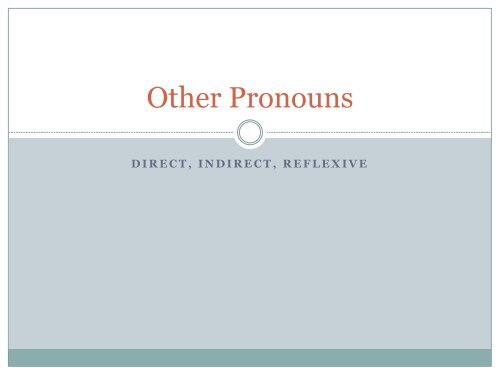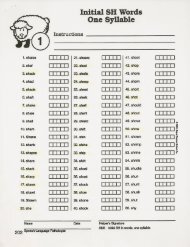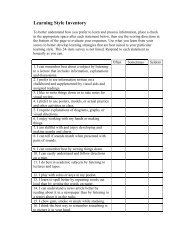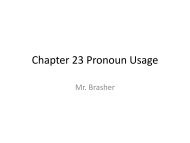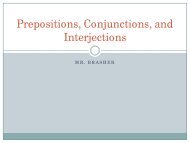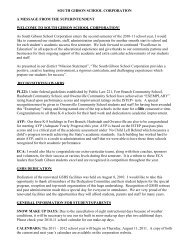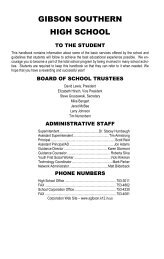Other Pronouns
Other Pronouns
Other Pronouns
- No tags were found...
You also want an ePaper? Increase the reach of your titles
YUMPU automatically turns print PDFs into web optimized ePapers that Google loves.
<strong>Other</strong> <strong>Pronouns</strong>D I R E C T , I N D I R E C T , R E F L E X I V E
Objetos directos• Answers the question who or what receives theaction of the verb.• Paco lee el libro. Paco reads the book.◦ Reads what? The book.• Some verbs in Spanish can have an understooddirect object. (escribir, preguntar, pedir, dar)
Los pronombres directos• Direct object pronouns replace the direct objectnoun.• Me• Te• Lo, La• Nos• Los, Las
Objetos indirectos• Answers the question to whom or what the action ofthe verb is intended.◦ Basically, who or what gets the direct object.• Paco le compra un libro a Eva. Paco is buying Evaa book.◦ Buys what? A book (direct object).◦ Who gets the book? Eva (indirect object).
Objetos indirectos• Indirect object pronouns may replace the indirectobject noun or may use both the noun and pronoun.◦ Remember the indirect object noun is always preceeded by a. A Eva le escribo.• If there is an indirect object in Spanish, you MUSTuse an indirect object pronoun.• You may have an indirect object in Spanish without astated direct object.
Los pronombres indirectos• Me• Te• Le• Nos• Les
Pronombres reflexivos• Reflexive pronouns are used whenever the action ofthe verb is happening to the subject.◦ Basically the subject and direct object are the same.• Reflexive pronouns agree with the verb conjugation.• Paco se lava los manos. Paco washes his hands.(the action of washing is happening to the subject)
Los pronombres reflexivos• Me• Te• Se• Nos• Seme lavote lavasse lavanos lavamosse lavan
Pronoun placement rules for Direct, Indirect, andReflexive pronouns• May be placed in front of the conjugated verb.◦ Lo compro. I’m buying it.◦ Te lavas la cara. You wash your face.
Pronoun placement rules for Direct, Indirect, andReflexive pronouns• May be attached to an infinitive verb.◦ Lo voy a comprar. I’m going to buy it.◦ Or, Voy a comprarlo. I’m going to buy it.
Pronoun placement rules for Direct, Indirect, andReflexive pronouns• May be attached to a present participle.◦ Estoy comprándolo. I’m buying it.• An accent mark will be required when attaching to apresent participle.◦ Over the a in ando.◦ Over the e in iendo or yendo.
Pronoun placement rules for Direct, Indirect, andReflexive pronouns• Must go before a negative command.◦ No lo compres. Don’t buy it.
Pronoun placement rules for Direct, Indirect, andReflexive pronouns• Must be attached to affirmative commands.◦ Cómpralo. Buy it.
Commands with pronouns and accents• An accent mark will be required if:• The command without the 1 pronoun is more than 1syllable Cómpralo Buy it.• The command has 2 pronouns attached. Dímelo Tell me it.
Commands with pronouns and accents• The accent mark will go over the 2 nd to last syllable ofverb without the pronouns attached.◦ Compra, the o is the 2 nd to last syllable. Cómpralo• Any 1 syllable command will only have an accentadded if it has 2 attached pronouns.◦ Di, only 1 syllable, but when 2 pronouns attached, add theaccent over the only syllable in the command. Dímelo.
Double object pronouns• When using both the direct and indirect objectpronouns together,• Place the indirect object pronoun first, then thedirect.• No me lo digas. Don’t tell me it.• ¡Dímelo! Tell me it!
Double object pronouns• If both pronouns begin with the letter L, change theindirect object pronoun to Se.• Place the indirect object pronoun first, then thedirect.• No le lo digas. No se lo digas. (Don’t tell her it.)• ¡Dílelo! ¡Díselo! (Tell her it!)
También• When attaching the reflexive pronoun nos to anosotros command, you must drop the s from theend of the command.• ¡Vámonos! Let’s go!


